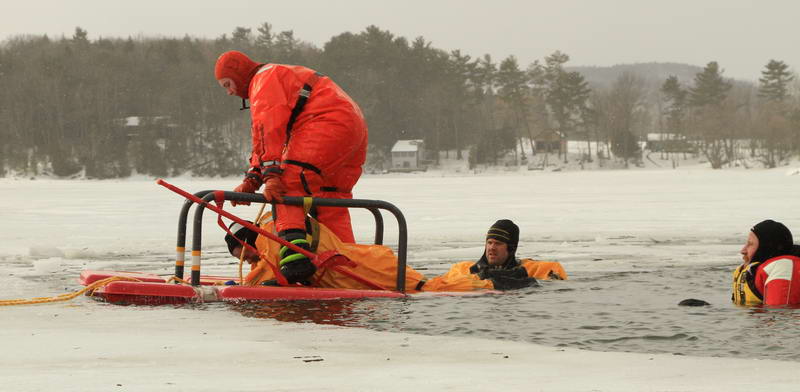 Charlotte and Shelburne Rescue practicing on Lake Champlain
Charlotte and Shelburne Rescue practicing on Lake Champlain
Incident Investigation
After an incident which involves rescue personnel, officials, for very good reasons, do not want people venturing onto the ice to check out the scene. The ice is is often dodgy in general and weak or nonexistent where the incident occurred. In some cases there might be continued work in the area to recover people or equipment.
Most of the time the official comments about the role of ice conditions in an accident that are offered to the public/press are general; along the lines of 'thin ice' or 'weak ice' or 'a crack in the ice'. As anyone who has spent some time on ice covered lakes (or who has read this website) knows, the situation is often more complicated than that. My rationale for visiting the scene of an incident is to understand the specific ice details that may have contributed to the outcome. In most cases these visits have resulted in a deeper understanding of the relevant ice conditions (click here for some recent reports). I believe this information will allow people who are trying to reduce their risk on ice to better understand and anticipate problematic ice.
It is helpful to see the ice as soon as reasonable as it can change quickly or get buried by snow. That sometimes means having to decide if it is reasonable to go out on what is likely to be dodgy ice. I do not go out on the ice if it is known to be too weak or is over moving water. When I do go out, I am well prepared. I always wear a dry suit, life-jacket, ice claws, helmet, and studded shoes. I carry a test pole and use it frequently. The test pole is very effective at identifying weak ice. In my pack I have a throw rope, a fully charged, water proof cell phone, a camera and measuring equipment. I typically bring a drill, an ice saw, and other equipment in a sled. If circumstances warrant doing so, I tether myself to shore with a very long rope. I try to notify property owners about what I am doing. When I can, I bring an experienced companion. I have many years of experience doing this.
I am aware there are both known and unknown risks and accept the consequences of taking those risks. I also recognize that there is a small chance I might do something stupid or be very unlucky and that could put rescue personal at risk. The steps I have taken to stay out of trouble make it likely that a rescue or recovery will be straight forward.
Bob

